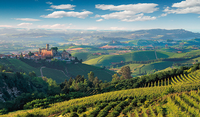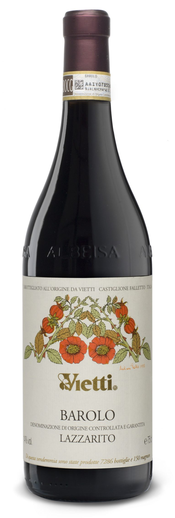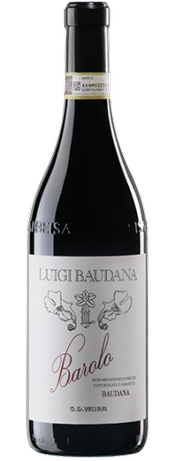I started writing about wine more than 25 years ago for The Washington Post, and over this span I have seen my colleagues write again and again—breathlessly—about more than a few “historically great” vintages. Not wishing to seem ridiculous, I’ve tried to avoid swooning over growing seasons that produced striking wines. This has proved to be a sound approach to critical writing about wine, preventing me from having to recant praise for a “best ever” vintage when another, even better one subsequently came around the corner.
But my turn to recant has come, as extensive blind tastings of 2016 vintage Barolo wines in the area last month have convinced me that these wines are even better than their extraordinary  predecessors from 2010. I was once sure that 2010 would be the best year I’d live to see from my beloved Barolo district, and though I’ve definitely not changed my mind about the greatness of the wines made in that year, I confess to having fallen even more deeply in love with the 2016s.
predecessors from 2010. I was once sure that 2010 would be the best year I’d live to see from my beloved Barolo district, and though I’ve definitely not changed my mind about the greatness of the wines made in that year, I confess to having fallen even more deeply in love with the 2016s.
Granted, they are not quite as dramatic and “impressive” as the 2010s, which combine acidic freshness, full ripeness, remarkable palate impact and big, tannic structure like no vintage I’ve ever experienced. But with that noted, along with my enduring conviction that I was wise to buy every single bottle from 2010 that I bought…the 2016s are more harmonious, proportional and simply beautiful wines as a group.
I don’t quite know how I’m going to manage to buy as many of the 2016s as their magnificence warrants, but I will find a way. Stated differently, don’t leave your wallet untended in my presence, no matter who you may be–family and friends included–as I’ll resort to almost anything to stock up on these wines and assure my happiness over the decades ahead.
I’m fully aware that all this gushing could come back to haunt me if another vintage of this caliber comes along before long, as my opening paragraph shows. Yet, I’m not much concerned about that happening, due the fact that I’m all-too-concerned that climate change in Barolo and Barbaresco simply won’t allow another growing season like 2016 to occur.
To cite a specific fact underlying this concern, the warmest segment of 2016 didn’t witness a single day when temperatures exceeded 35 degrees Centigrade. Based on recent trends, that’s a record that may take a long time to break–if ever–in this rapidly warming region. However, adding in another couple of facts will help  indicate how truly historic 2016 will likely look in retrospect: The Nebbiolo fruit in Barolo and Barbaresco achieved absolutely full ripeness despite the aforementioned lack of heat spikes, as proved by average measured quantities of malic acid below 1 gram per liter.
indicate how truly historic 2016 will likely look in retrospect: The Nebbiolo fruit in Barolo and Barbaresco achieved absolutely full ripeness despite the aforementioned lack of heat spikes, as proved by average measured quantities of malic acid below 1 gram per liter.
Add to that the third fact that average alcohol levels were quite moderate despite perfect ripeness, and you could start to believe that the ancient Roman goddess Fortuna blessed this vintage. Could this combination of factors ever recur, or even be surpassed? Sure, anything is possible, in the same sense that it is possible that Wayne Gretzky’s NHL record for hockey assists will be equaled, or that pigs will fly.
How do I love thee, 2016s? Let me count the ways. First, the wines are beautiful to behold, with excellent color at this point in their development, and rarely the slightest hint of any premature brick-ish tint, as with some wines from hot years like 2011.
Second, their bouquets are very expressive as a rule, with lovely floral scents (think violets) but almost never any aromatic suggestion of stewed fruits.
Third, they show generous flavors with a lovely streak of sweetness, but their generosity almost never tips over the line separating stylishness from flamboyance, just as their sweetness never seems candied, as can result when sugars in the grapes soar during heat spikes at harvest time.
Fourth, they hold lots of tannins, but ones that are very fine in grain and almost never overly astringent, even with some still-to-be-absorbed wood tannins still evident in these very young wines. Consequently, they exhibit just the right degree of “grip” in their finishes to balance and frame the lovely fruit without foreshortening the aftertaste of the wines.
Fifth, there is an (almost uncanny) inner proportionality and harmony in a very high percentage of the wines. This may look strange in print, but their deliciousness comes across as effortless: None of their elements seem to be pushing or pulling against any of the other flavor or structural elements. Everything fits, and everything seems to have fit in easily.
Finally, and following from the last point, these wines will be incredibly easy to enjoy when young…needing a lot less time to settle and soften and integrate than the 2010s. The ‘10s were also very balanced in terms of acidity and ripeness, but did a lot more pushing and pulling to achieve balance in their youth, and took a lot longer than the ‘16s will need to hit their stride.
Indeed, many of the 2016s have already hit their stride, with the likely result that a lot of them will be consumed before they can attain their full potential. Graceful as they are, they will be hard to resist in the years immediately ahead. However, savvy consumers will be handsomely rewarded for disciplined restraint, as these wines will remain graceful as they become even more complex while tertiary notes from time in bottle are layered over their lovely primary fruit and generally restrained oak treatment.
I’ve already published reviews of some amazing releases from the villages (or comunes) of Roddi and Serralunga d’Alba, and will continue publishing more on the “Reviews” page of WRO in the weeks ahead. I’ll then pull a large set of them together when my column slot next rolls around in mid-March. For now, though, I’ll tack on a few reviews that can exemplify some of the particular virtues embodied in wines from this extraordinary vintage. The tone of the reviews won’t be much less breathless than this overview, but they’ll lend some specificity that may make my fawning praise seem a bit more plausible:
Vietti (Serralunga d’Alba) 2016 “Lazzarito” ($200): In the 2015 vintage, I thought “Ravera” from Novello was Vietti’s best bottling (and my “Wine of the Year” for all of 2019), but this Lazzarito is my pick from 2016. It is breathtakingly impressive, with an almost eerie combination of power and grace. For example, it is hugely flavorful but not huge, really being just medium-bodied. Similarly, it carries loads of tannin, but so fine-grained that there isn’t the slightest sensory astringency, even  at the end of the finish. The proportions of everything seem unquestionable, and the integration of the elements is likewise seemingly perfect: Acid, fruit, tannin, wood…everything is just right, and everything lets everything else express itself. Delicious now, but surely even better 25 years from now, this is the kind of wine that can defy belief that such a work of art could result from…grapes. I may be under-scoring this at: 99
at the end of the finish. The proportions of everything seem unquestionable, and the integration of the elements is likewise seemingly perfect: Acid, fruit, tannin, wood…everything is just right, and everything lets everything else express itself. Delicious now, but surely even better 25 years from now, this is the kind of wine that can defy belief that such a work of art could result from…grapes. I may be under-scoring this at: 99
Ettore Germano (Serralunga d’Alba) 2016 “Cerretta” ($70): This is an already-superb house that still seems to get stronger with each passing vintage, and here’s a fabulous case in point. Fresh and pretty in line with the vintage, but also with prodigious depth and power as expected from Serralunga, this is an obviously great 2016 Barolo. It isn’t weighty, but the depth of flavor seems almost bottomless. Similarly, it is quite expressive and complex, but there’s really nothing “showy” about it. Rather, its excellence seems “effortless,” a term that reappears frequently in my raw notes from blind tasting the top 2016s. A wine of great beauty, but of the classiest sort…as in Grace Kelly beauty. 97
G. D. Vajra (Serralunga d’Alba) 2016 “Baudana” ($85): The 2016 vintage was truly a great one for the Vajra family, as this wine clearly demonstrates. This is rich and even succulent, but still structured and capable of aging gracefully in a positive direction even though it is delicious now. The fruit shows great expressive punch, but still, this is hardly a mere fruit bomb, as the accents of cola and cured meat are wonderfully alluring and just as prominent overall as the pure fruit notes. Probably the best this bottling has looked since 2006, and I’d rather own this vintage than that one, though I’ll soon own both once this becomes available. 96
1
